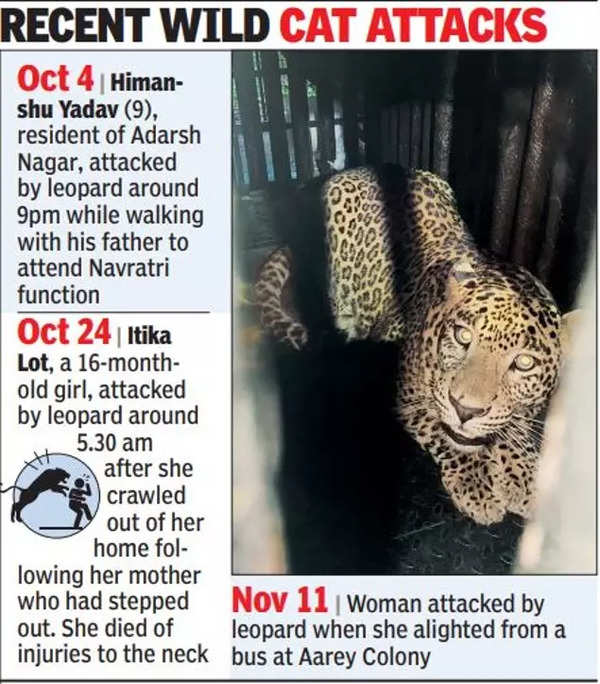Top Searches
- News
- City News
- mumbai News
- Mumbai: Female leopard seen on camera near spot of Aarey infant killing
Mumbai: Female leopard seen on camera near spot of Aarey infant killing

The forest department has zeroed in on a 3-4 year old female leopard who was caught on a camera trap just 15 minutes after the attack on an infant, Itika Lot, on October 24. The leopard was photographed in close vicinity of the attack spot. The child died while undergoing treatment in hospital due to serious neck injuries.
MUMBAI: The forest department has zeroed in on a 3-4 year old female leopard who was caught on a camera trap just 15 minutes after the attack on an infant, Itika Lot, on October 24. The leopard was photographed in close vicinity of the attack spot. The child died while undergoing treatment in hospital due to serious neck injuries.

Following the infant's death, two male leopards of the same age had been trapped within a few days of each other. The two male leopards have a female sibling.
Santhosh Sasthe, deputy conservators of forests, Thane Range, under whose jurisdiction the Aarey Colony falls, said the camera picture was matched with existing records and the female leopard has been identified.
"We immediately wrote to the principal chief conservator of forests, seeking permission to trap the animals which has been granted," he said. The permission is valid for 30 days.
Around 30 camera traps, cages have been set up around units 15 and 16 in Aarey Colony where leopard attacks have been reported.
If it is established that it is the female leopard that is responsible for the attack on Itika, the other two will be set free, said officials.
"Our forest guards are carrying out night patrolling with volunteers from various NGOs. Every morning and evening we make loudspeaker announcements in settlements, warning people not to step out after dusk and early morning and to be especially careful about children," said Sasthe.
He said the Friday night attack on the woman took place after she alighted from a bus. "The bus stop is nearly 500-600 metres from a human settlement and she was alone. We have warned people not to move around alone after dusk," he said.
Sources said the child's unfortunate death was on account of human error. The mother had stepped out early morning at 5.30 for the temple and the child crawled after her. It is a known leopard habitat and residents are aware they must be extra careful about children. We cannot blame the leopard in this incident," said a source.
Aarey activists blamed shrinking green cover in the colony for rise in man-animal conflicts. From cutting of huge branches of trees, increasing encroachments, fragmentation of the forest owing to infrastructure projects, uncleared garbage dumps are some of the pressure points, they said.
Forest officials point to large number of Adivasi padas in Sanjay Gandhi National Park but absence of man-animal conflict as tribals follow rules of the jungle.

Following the infant's death, two male leopards of the same age had been trapped within a few days of each other. The two male leopards have a female sibling.
Santhosh Sasthe, deputy conservators of forests, Thane Range, under whose jurisdiction the Aarey Colony falls, said the camera picture was matched with existing records and the female leopard has been identified.
"We immediately wrote to the principal chief conservator of forests, seeking permission to trap the animals which has been granted," he said. The permission is valid for 30 days.
Around 30 camera traps, cages have been set up around units 15 and 16 in Aarey Colony where leopard attacks have been reported.
If it is established that it is the female leopard that is responsible for the attack on Itika, the other two will be set free, said officials.
"Our forest guards are carrying out night patrolling with volunteers from various NGOs. Every morning and evening we make loudspeaker announcements in settlements, warning people not to step out after dusk and early morning and to be especially careful about children," said Sasthe.
He said the Friday night attack on the woman took place after she alighted from a bus. "The bus stop is nearly 500-600 metres from a human settlement and she was alone. We have warned people not to move around alone after dusk," he said.
Sources said the child's unfortunate death was on account of human error. The mother had stepped out early morning at 5.30 for the temple and the child crawled after her. It is a known leopard habitat and residents are aware they must be extra careful about children. We cannot blame the leopard in this incident," said a source.
Aarey activists blamed shrinking green cover in the colony for rise in man-animal conflicts. From cutting of huge branches of trees, increasing encroachments, fragmentation of the forest owing to infrastructure projects, uncleared garbage dumps are some of the pressure points, they said.
Forest officials point to large number of Adivasi padas in Sanjay Gandhi National Park but absence of man-animal conflict as tribals follow rules of the jungle.
FOLLOW US ON SOCIAL MEDIA
FacebookTwitterInstagramKOO APPYOUTUBE
Start a Conversation
end of article









